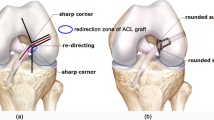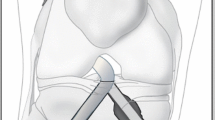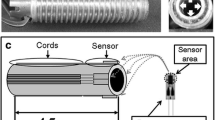Abstract
Bone tunnel enlargement is a common effect associated with knee laxity after anterior cruciate ligament (ACL) reconstruction. Nevertheless, its exact pathomechanism remains controversial. One of the possible reasons could be bone remodeling due to tunnel creation, which changes the stress environment in the joint. The present study aims to characterize the deteriorated stress distribution on the articular surface, which is due to tunnel creation after single-bundle or double-bundle ACL reconstruction. The stress distributions in the knee following ACL reconstruction under the compression, rotation, and valgus torques were calculated using a validated three-dimensional finite element (FE) model. The results indicate that, (a) under compression, von Mises stress is decreased at lateral and posteromedial regions of single/anteromedial (AM) tunnel, whereas it is increased at anterior region of single/AM tunnel in tibial subchondral bone; (b) the concentration of tensile stress is transferred from the articular surface to the location of graft fixation, and tensile stress in subchondral plate is decreased after ACL reconstruction; (c) severe stress concentration occurs between AM and posterolateral tunnels following the double-bundle reconstruction, which may contribute to the tunnel communication after surgery. In summary, the present study affirms that the deterioration of stress distribution occurs near the articular surface, which may cause the collapse of the tunnel wall, and lead to tunnel enlargement. The present study provides an insight into the effect of tunnel creation on articular stress deterioration after single-bundle or double-bundle ACL reconstruction. These findings provide knowledge on the effect of tunnel enlargement after ACL reconstruction in the long term.












Similar content being viewed by others
References
Abaqus Analysis User’s Manual. In: The Documentation for Abaqus 6.10, Vol. V, Part IX. USA: Simulia, Inc., pp. 34.1.2–3.
Abaqus Analysis User’s Manual. In: The Documentation for Abaqus 6.10, Vol. IV, Part VI. USA: Simulia, Inc., pp. 28.1.5–64.
Au, A. G., et al. A three-dimensional finite element stress analysis for tunnel placement and buttons in anterior cruciate ligament reconstructions. J. Biomech. 38(4):827–832, 2005.
Blankevoort, L., et al. Articular contact in a three-dimensional model of the knee. J. Biomech. 24(11):1019–1031, 1991.
Boyd, S. K., R. Muller, and R. F. Zernicke. Mechanical and architectural bone adaptation in early stage experimental osteoarthritis. J. Bone Miner. Res. 17(4):687–694, 2002.
Boyle, C., and I. Y. Kim. Three-dimensional micro-level computational study of Wolff’s law via trabecular bone remodeling in the human proximal femur using design space topology optimization. J. Biomech. 44(5):935–942, 2011.
Carter, D. R., T. Orr, and D. P. Fyhrie. Relationships between loading history and femoral cancellous bone architecture. J. Biomech. 22(3):231–244, 1989.
Castañeda, S., J. Roman-Blas, R. Largo, and G. Herrero-Beaumont. Subchondral bone as a key target for osteoarthritis treatment. Biochem. Pharmacol. 83(3):315–323, 2011.
Chhabra, A., et al. Anatomic, radiographic, biomechanical, and kinematic evaluation of the anterior cruciate ligament and its two functional bundles. J. Bone Joint Surg. Am. 88(Suppl 4):2–10, 2006.
Donahue, T. L., et al. A finite element model of the human knee joint for the study of tibio-femoral contact. J. Biomech. Eng. 124(3):273–280, 2002.
Ferretti, M., et al. Osseous landmarks of the femoral attachment of the anterior cruciate ligament: an anatomic study. Arthroscopy 23(11):1218–1225, 2007.
Frost, H. M. A 2003 update of bone physiology and Wolff’s Law for clinicians. Angle Orthod. 74(1):3–15, 2004.
Fu, F. H., et al. Current trends in anterior cruciate ligament reconstruction. Part II. Operative procedures and clinical correlations. Am. J. Sports Med. 28(1):124–130, 2000.
Fukubayashi, T., and H. Kurosawa. The contact area and pressure distribution pattern of the knee. A study of normal and osteoarthrotic knee joints. Acta Orthop. Scand. 51(6):871–879, 1980.
Goulet, R. W., S. A. Goldstein, M. J. Ciarelli, J. L. Kuhn, M. B. Brown, and L. A. Feldkamp. The relationship between the structural and orthogonal compressive properties of trabecular bone. J. Biomech. 27(4):375–389, 1994.
Huiskes, R., et al. Adaptive bone-remodeling theory applied to prosthetic-design analysis. J. Biomech. 20(11–12):1135–1150, 1987.
Jagodzinski, M., et al. Analysis of forces of ACL reconstructions at the tunnel entrance: is tunnel enlargement a biomechanical problem? J. Biomech. 38(1):23–31, 2005.
Kannus, P., and M. Jarvinen. Conservatively treated tears of the anterior cruciate ligament. Long-term results. J. Bone Joint Surg. Am. 69(7):1007–1012, 1987.
Kopf, S., et al. Effect of tibial drill angles on bone tunnel aperture during anterior cruciate ligament reconstruction. J. Bone Joint Surg. Am. 92(4):871–881, 2010.
Kopf, S., et al. The ability of 3 different approaches to restore the anatomic anteromedial bundle femoral insertion site during anatomic anterior cruciate ligament reconstruction. Arthroscopy 27(2):200–206, 2011.
Kutzner, I., et al. Loading of the knee joint during activities of daily living measured in vivo in five subjects. J. Biomech. 43(11):2164–2173, 2010.
Li, G., J. Suggs, and T. Gill. The effect of anterior cruciate ligament injury on knee joint function under a simulated muscle load: a three-dimensional computational simulation. Ann. Biomed. Eng. 30(5):713–720, 2002.
Li, G., et al. A validated three-dimensional computational model of a human knee joint. J. Biomech. Eng. 121(6):657–662, 1999.
Li, R. T., et al. Predictors of radiographic knee osteoarthritis after anterior cruciate ligament reconstruction. Am. J. Sports Med. 39(12):2595–2603, 2011.
Louboutin, H., et al. Osteoarthritis in patients with anterior cruciate ligament rupture: a review of risk factors. Knee 16(4):239–244, 2009.
Mellal, A., et al. Stimulating effect of implant loading on surrounding bone. Comparison of three numerical models and validation by in vivo data. Clin. Oral Implants Res. 15(2):239–248, 2004.
Milz, S., and R. Putz. Quantitative morphology of the subchondral plate of the tibial plateau. J. Anat. 185:103–110, 1994.
Netravali, N. A., et al. The effect of kinematic and kinetic changes on meniscal strains during gait. J. Biomech. Eng. 133(1):011006, 2011.
Park, S., and G. A. Ateshian. Dynamic response of immature bovine articular cartilage in tension and compression, and nonlinear viscoelastic modeling of the tensile response. J. Biomech. Eng. 128(4):623–630, 2006.
Pena, E., et al. A three-dimensional finite element analysis of the combined behavior of ligaments and menisci in the healthy human knee joint. J. Biomech. 39(9):1686–1701, 2006.
Pombo, M. W., W. Shen, and F. H. Fu. Anatomic double-bundle anterior cruciate ligament reconstruction: where are we today? Arthroscopy 24(10):1168–1177, 2008.
Radin, E. L., and R. M. Rose. Role of subchondral bone in the initiation and progression of cartilage damage. Clin. Orthop. Relat. Res. 213:34–40, 1986.
Radin, E. L., et al. The role of bone changes in the degeneration of articular cartilage in osteoarthrosis. Acta Orthop. Belg. 44(1):55–63, 1978.
Reilly, D. T., and A. H. Burstein. The elastic and ultimate properties of compact bone tissue. J. Biomech. 8(6):393–405, 1975.
Sandberg, R., et al. Operative versus non-operative treatment of recent injuries to the ligaments of the knee. A prospective randomized study. J. Bone Joint Surg. Am. 69(8):1120–1126, 1987.
Siebold, R. Observations on bone tunnel enlargement after double-bundle anterior cruciate ligament reconstruction. Arthroscopy 23(3):291–298, 2007.
Song, Y., et al. A three-dimensional finite element model of the human anterior cruciate ligament: a computational analysis with experimental validation. J. Biomech. 37(3):383–390, 2004.
Taylor, M., K. E. Tanner, and M. A. Freeman. Finite element analysis of the implanted proximal tibia: a relationship between the initial cancellous bone stresses and implant migration. J. Biomech. 31(4):303–310, 1998.
van Eck, C. F., et al. Anatomic single- and double-bundle anterior cruciate ligament reconstruction flowchart. Arthroscopy 26(2):258–268, 2010.
Wilson, T. C., et al. Tunnel enlargement after anterior cruciate ligament surgery. Am. J. Sports Med. 32(2):543–549, 2004.
Wolf, J. H. Julis Wolff and his “law of bone remodeling”. Orthopade 24(5):378–386, 1995.
Xu, Y., et al. Relation of tunnel enlargement and tunnel placement after single-bundle anterior cruciate ligament reconstruction. Arthroscopy 27(7):923–932, 2011.
Yagi, M., et al. Biomechanical analysis of an anatomic anterior cruciate ligament reconstruction. Am. J. Sports Med. 30(5):660–666, 2002.
Yao, J., et al. Stresses and strains in the medial meniscus of an ACL deficient knee under anterior loading: a finite element analysis with image-based experimental validation. J. Biomech. Eng. 128(1):135–141, 2006.
Acknowledgment
We thank Dr. Gong He for her very kind suggestions of the study design and results analysis, Dr. Kuang Guanming for advice on the surgery process, Dr. Wang Ting for advice on model development, and MR Henry Fong for editing manuscript. The present study was supported by grants from the National Natural Science Foundation of China (NSFC Grants 10925208 and 11120101001) and the National Key Lab of Virtual Reality Technology. The sponsors had no role in any aspect of the study, including data collection and analysis, manuscript preparation, or the authorization for publication.
Conflict of interest
We declare that the authors are not in any financial or personal relationship with people or organizations that may influence the present work; there is no professional or personal interest of any kind in any product, service, and/or company that may construe to influence the position presented in or the review of, the present manuscript.
Author information
Authors and Affiliations
Corresponding authors
Additional information
Associate Editor Michael R. Torry oversaw the review of this article.
J. Yao and C. Wen equally contributed to this work.
Rights and permissions
About this article
Cite this article
Yao, J., Wen, C., Cheung, J.TM. et al. Deterioration of Stress Distribution Due to Tunnel Creation in Single-Bundle and Double-Bundle Anterior Cruciate Ligament Reconstructions. Ann Biomed Eng 40, 1554–1567 (2012). https://doi.org/10.1007/s10439-012-0517-4
Received:
Accepted:
Published:
Issue Date:
DOI: https://doi.org/10.1007/s10439-012-0517-4




